
Aimery of Lusignan, erroneously referred to as Amalric or Amaury in earlier scholarship, was the first king of Cyprus, reigning from 1196 to his death in 1205. He also reigned as the king of Jerusalem from his marriage to Queen Isabella I in 1197 to his death. He was a younger son of Hugh VIII of Lusignan, a nobleman in Poitou. After participating in a rebellion against Henry II of England in 1168, he went to the Holy Land and settled in the Kingdom of Jerusalem.
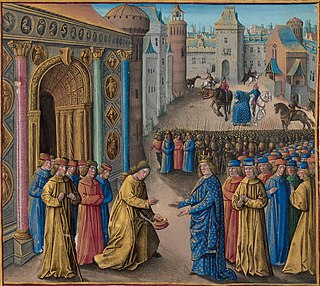
Year 1148 (MCXLVIII) was a leap year starting on Thursday of the Julian calendar.

Melisende was the queen of Jerusalem from 1131 to 1152. She was the first female ruler of the Kingdom of Jerusalem and the first woman to hold a public office in the crusader kingdom. She became legendary already in her lifetime for her generous support of the various Christian communities in her kingdom. Contemporary chronicler William of Tyre praised her wisdom and abilities, while modern historians differ in their assessment.

Baldwin III was King of Jerusalem from 1143 to 1163. He was the eldest son of Melisende and Fulk of Jerusalem. He became king while still a child, and was at first overshadowed by his mother Melisende, whom he eventually defeated in a civil war. During his reign Jerusalem became more closely allied with the Byzantine Empire, and the Second Crusade tried and failed to conquer Damascus. Baldwin captured the important Egyptian fortress of Ascalon, but also had to deal with the increasing power of Nur ad-Din in Syria. He died childless and was succeeded by his brother Amalric.
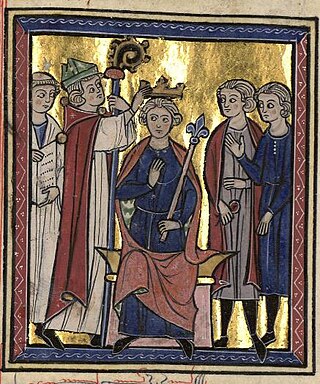
Fulk, also known as Fulk the Younger, was King of Jerusalem with his wife, Queen Melisende, from 1131 until his death in 1143. Previously, he was Count of Anjou, as Fulk V, from 1109 to 1129. During Fulk's reign, the Kingdom of Jerusalem reached its largest territorial extent.

Baldwin II, also known as Baldwin of Bourcq or Bourg, was Count of Edessa from 1100 to 1118, and King of Jerusalem from 1118 until his death. He accompanied Godfrey of Bouillon and Baldwin of Boulogne to the Holy Land during the First Crusade. He succeeded Baldwin of Boulogne as the second count of Edessa when he left the county for Jerusalem following his brother's death. He was captured at the Battle of Harran in 1104. He was held first by Sökmen of Mardin, then by Jikirmish of Mosul, and finally by Jawali Saqawa. During his captivity, Tancred, the Crusader ruler of the Principality of Antioch, and Tancred's cousin, Richard of Salerno, governed Edessa as Baldwin's regents.
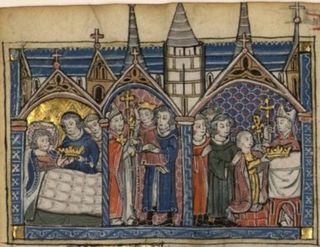
Raymond III was count of Tripoli from 1152 to 1187. He was a minor when Nizari Assassins murdered his father, Count Raymond II of Tripoli. His cousin King Baldwin III of Jerusalem, who was staying in Tripoli, made Raymond's mother, Hodierna of Jerusalem, regent. Raymond spent the following years at the royal court in Jerusalem. He reached the age of majority in 1155, after which he participated in a series of military campaigns against Nur ad-Din, the Zengid ruler of Damascus. In 1161 he hired pirates to pillage the Byzantine coastline and islands to take vengeance on Byzantine emperor Manuel I Komnenos, who had refused to marry his sister Melisende. He was captured in the Battle of Harim by Nur ad-Din's troops on 10 August 1164, and imprisoned in Aleppo for almost ten years. During his captivity, his cousin King Amalric of Jerusalem administered the county of Tripoli on his behalf.

The Kingdom of Jerusalem, one of the Crusader states that was created in 1099, was divided into a number of smaller seigneuries. According to the 13th-century jurist John of Ibelin, the four highest crown vassals in the kingdom proper were the count of Jaffa and Ascalon, the prince of Galilee, the lord of Sidon, and the lord of Oultrejordain.

Philip of Milly, also known as Philip of Nablus, was a baron in the Kingdom of Jerusalem and the seventh Grand Master of the Knights Templar. He briefly employed the troubadour Peire Bremon lo Tort in the Holy Land.
Barisan of Ibelin was the first lord of Ibelin and the founder of the House of Ibelin in the crusader Kingdom of Jerusalem. His name was later written as "Balian" and he is sometimes known as Balian the Elder, Barisan the Old or Balian I. Barisan was also lord of Ramla from 1138 to 1150.
Hugh of Ibelin was an important noble in the Kingdom of Jerusalem and was Lord of Ramla from 1152-1169.

The siege of Damascus took place between 24 and 28 July 1148, during the Second Crusade. It ended in a crusader defeat and led to the disintegration of the crusade. The two main Christian forces that marched to the Holy Land in response to Pope Eugene III and Bernard of Clairvaux's call for the Second Crusade were led by Kings Louis VII of France and Conrad III of Germany. Both faced disastrous marches across Anatolia in the months that followed, with most of their armies being destroyed. The original focus of the crusade was Edessa (Urfa), but in Jerusalem, the preferred target of King Baldwin III and the Knights Templar was Damascus. At the Council of Acre, magnates from France, Germany, and the Kingdom of Jerusalem decided to divert the crusade to Damascus.

The principality of Galilee was one of the four major seigneuries of the crusader Kingdom of Jerusalem, according to 13th-century commentator John of Ibelin, grandson of Balian. The direct holdings of the principality centred around Tiberias, in Galilee proper, but with all its vassals, the lordship covered all Galilee and southern Phoenicia. The independent Lordship of Sidon was located between Galilee's holdings. The principality also had its own vassals: the Lordships of Beirut, Nazareth, and Haifa.
Manasses of Hierges was an important crusader and constable of the Kingdom of Jerusalem. He was lord of Ramla from 1150 to 1152.

The siege of Ascalon took place from 25 January to 22 August 1153, in the time period between the Second and Third Crusades, and resulted in the capture of the Fatimid Egyptian fortress by the Kingdom of Jerusalem. Ascalon was an important castle that was used by the Fatimids to launch raids into the Crusader kingdom's territory, and by 1153 it was the last coastal city in Palestine that was not controlled by the Crusaders.
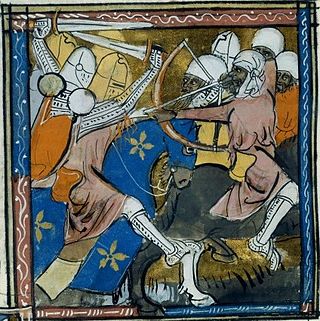
Hugh of Fauquembergues, also known as Hugh of St Omer, Hugh of Falkenberg, or Hugh of Falchenberg was Prince of Galilee from 1101 to his death. He was Lord of Fauquembergues before joining the First Crusade. Baldwin I of Jerusalem granted him Galilee after its first prince, Tancred, who was Baldwin's opponent, had voluntarily renounced it. Hugh assisted Baldwin against the Fatimids and made raids into Seljuk territories. He established the castles of Toron and Chastel Neuf. He died fighting against Toghtekin, Atabeg of Damascus.
William of Bures was Prince of Galilee from 1119 or 1120 to his death. He was descended from a French noble family which held estates near Paris. William and his brother, Godfrey, were listed among the chief vassals of Joscelin of Courtenay, Prince of Galilee, when their presence in the Holy Land was first recorded in 1115. After Joscelin received the County of Edessa from Baldwin II of Jerusalem in 1119, the king granted the Principality of Galilee to William. He succeeded Eustace Grenier as constable and bailiff in 1123. In his latter capacity, he administered the kingdom during the Baldwin II's captivity for more than a year, but his authority was limited.
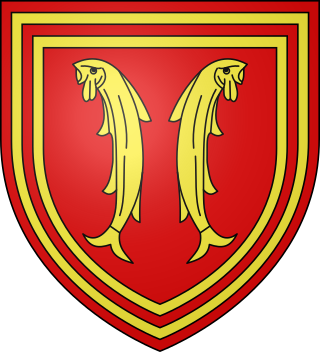
Odo of Montbéliard was a leading baron of the crusader Kingdom of Jerusalem in the early 13th century. He often held the highest offices in the kingdom including bailli (viceroy) and constable.
Eschiva of Bures, also known as Eschiva II, was Princess of Galilee in the Kingdom of Jerusalem from 1158 to 1187.

The timeline of the Kingdom of Jerusalem presents important events in the history of the Kingdom of Jerusalem—a Crusader state in modern day Israel and Jordan—in chronological order. The kingdom was established after the First Crusade in 1099. Its first ruler Godfrey of Bouillon did not take the title of king and swore fealty to the Latin Patriarch of Jerusalem, Daimbert. Godfrey's brother and successor Baldwin I was crowned the first king of Jerusalem without doing homage to the patriarch in 1100. By 1153, Baldwin I and his successors captured all towns on the Palestinian coast with the support of Pisan, Genoese and Venetian fleets and also took control of the caravan routes between Egypt and Syria. The kings regularly administered other crusader states—the Counties of Edessa and Tripoli and the Principality of Antioch—on behalf of their absent or underage rulers.














